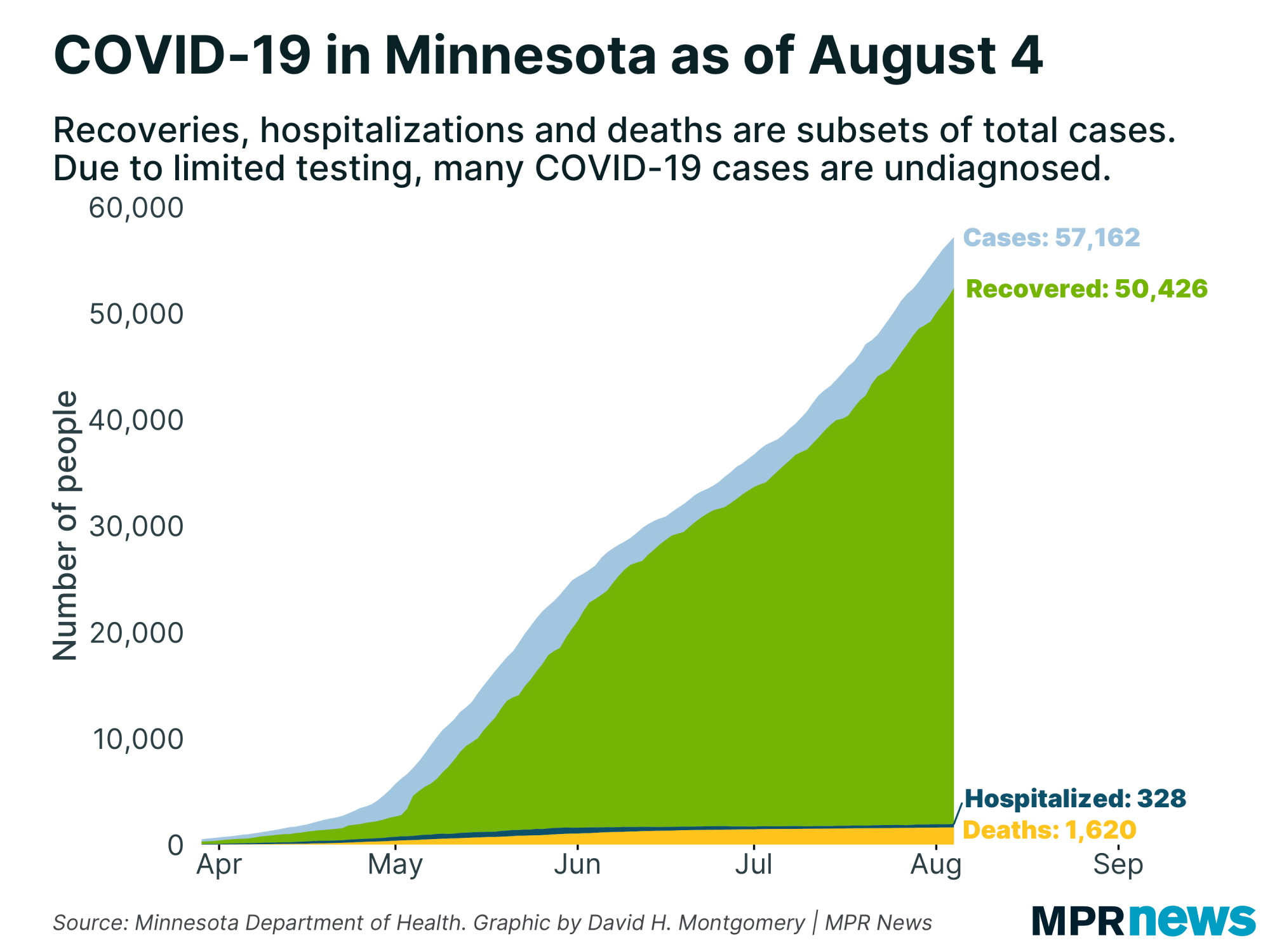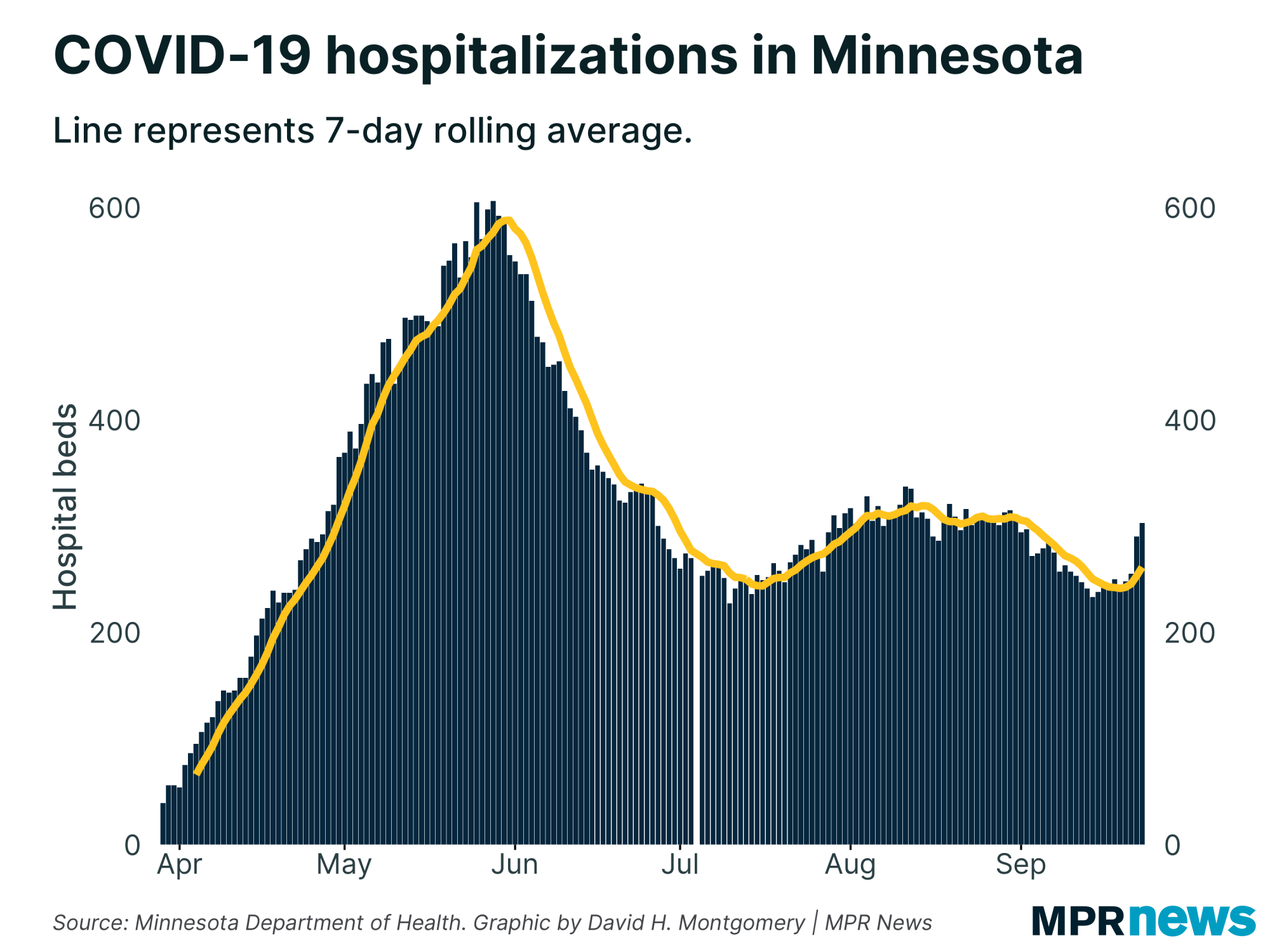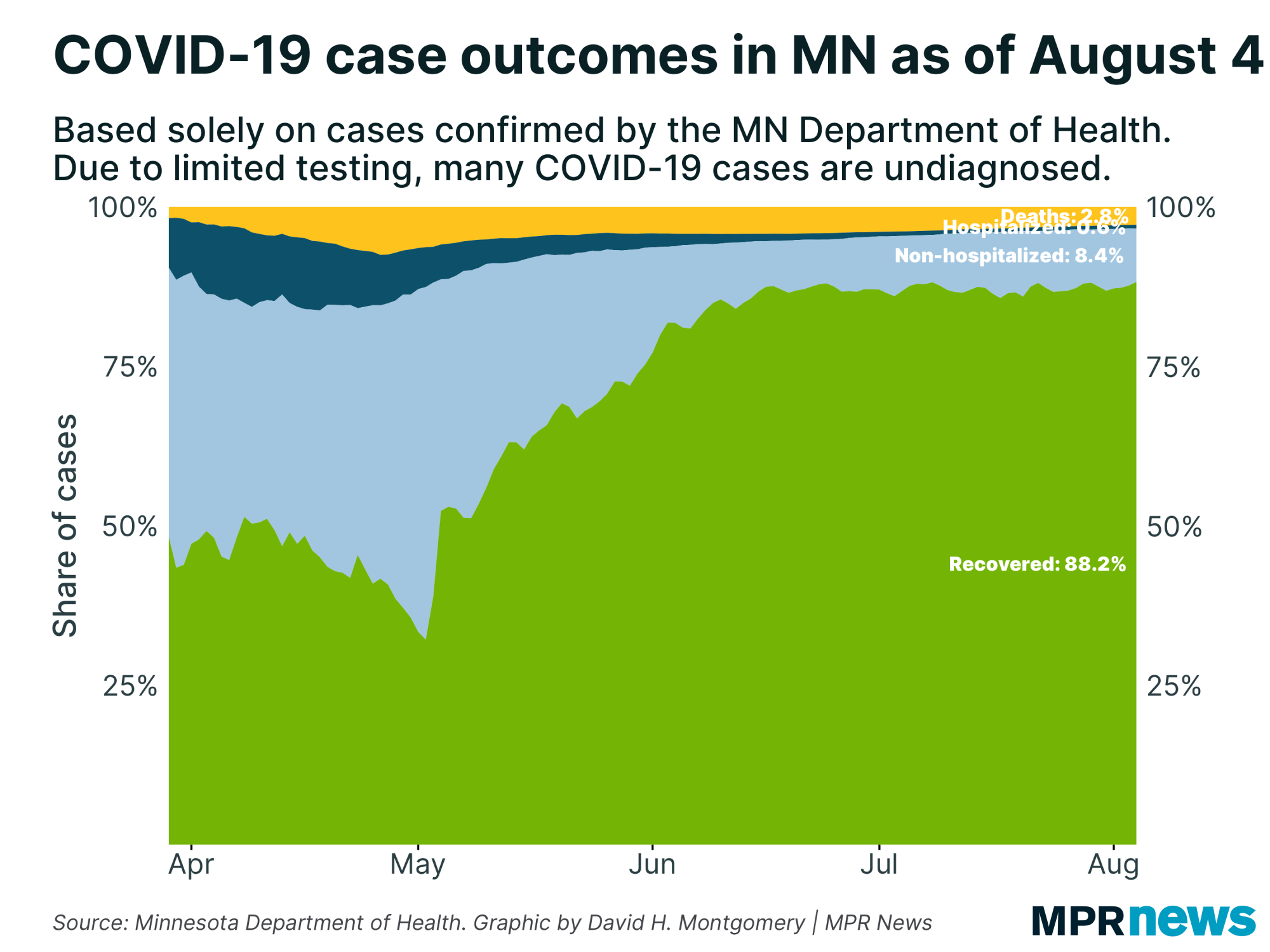July 24 update on COVID-19 in MN: 773 new cases as pandemic total nears 50K

Go Deeper.
Create an account or log in to save stories.
Like this?
Thanks for liking this story! We have added it to a list of your favorite stories.
Updated 6:39 p.m.
Minnesota’s monthlong climb in new COVID-19 cases continued Friday as the Health Department reported another 773 cases, along with five more deaths.
Current hospitalizations (278) and the number of those needing intensive care (108) stayed roughly flat from the prior day, although officials have been bracing Minnesotans to expect hospitalizations to climb following several weeks of a surge in new confirmed cases.
One of the state’s top public health experts on Friday also warned Minnesotans to beware of scammers who may be calling people posing as state health investigators.
The Health Department knows of an instance where someone received a call claiming to be a health investigator following up on a possible COVID-19 exposure — but then asking for a credit card number so that a testing kit could be sent.
Turn Up Your Support
MPR News helps you turn down the noise and build shared understanding. Turn up your support for this public resource and keep trusted journalism accessible to all.
While state officials are calling people about possible exposure as they work to trace the disease and stem the spread, “we will never ask for credit card information. We will never ask you for any money,” Kris Ehresmann, the state’s infectious disease director, told reporters.
“That is out there,” she said, but “that is not something that’s coming from public health.”

Of the 49,488 positive cases in Minnesota since the start of the pandemic, about 87 percent of people infected have recovered to the point they no longer need to be isolated.
Among the 1,566 people who’ve died from the disease in Minnesota so far, about 77 percent had been living in long-term care or assisted living facilities. Friday’s report continues a trend since late June of daily deaths in the single digits.
‘Small sacrifice’
The newest counts come as Gov. Tim Walz’s statewide mask-wearing order for restaurants, stores and other public indoor gathering spaces is set to take effect first thing Saturday.
Walz on Wednesday announced a statewide mask mandate as a way to stem the spread of COVID-19 and put the state on a path back to normalcy.

“This is the quickest way to ending the COVID pandemic,” he told reporters. “It is the surest way to getting us to the therapeutics and vaccines” while continuing to reopen the economy.
If 90 to 95 percent of Minnesotans complied, businesses could stay open, kids could return safely to school buildings, and we "get back that life that we all miss so much,” he said.
Ehresmann on Friday said it would be several weeks before officials could assess the impact of Minnesota's new mask mandate.
“We kind of look at a 21-day window,” she said during Friday’s briefing. “We really are hoping, based on what's been seen in other locations, that we're going to see the positive impact of this mandate — but it won't be instantaneous.”
Under the order, businesses will have to post notice of the new regulations and ensure patrons comply. Children age 5 and younger are exempt. Cities with tougher ordinances can go beyond the state indoor-only rules.
Walz compared the inconvenience of wearing a mask to wearing seat belts in cars and preventing smoking in indoor spaces, changes in behavior required by government that ultimately saved lives. “This is a small sacrifice for a potential big gain,” he said.
No ‘mask police’
The state is working now with local chambers of commerce around the state to make masks available to businesses to give to customers who don’t have one.
Officials don’t want businesses to be in a position of being “mask police,” said Steve Grove, commissioner of the Department of Employment and Economic Development.
If a patron says she can’t wear a mask for medical reasons, store owners can allow it without delving into deeper explanations, he said. Bar and restaurant patrons don’t have to keep masks on as they eat and drink at a table with their party.

The order does allow for a petty misdemeanor with possible fine up to $100. Businesses could face steeper fines for noncompliance.
Walz, though, said he wants authorities “handing out masks, not tickets” and that businesses should not escalate confrontations, adding: "We don't want someone to accidentally get famous on the internet because they're throwing a tantrum in Trader Joe's."
Cases growing across age brackets, up north
State health officials continue to worry about the recent spike of coronavirus cases in younger Minnesotans, including that those infected will inadvertently spread the virus to grandparents and other more vulnerable populations.
Minnesotans in their 20s now make up the age group with the most confirmed cases in the pandemic, with more than 11,600. The median age of Minnesotans infected has been trending down in recent weeks and is now 36 years old.

Health investigators are now starting to see more cases in 30- and 40-somethings as more people get together for family gatherings and summer fun without social distancing, Ehresmann said earlier in the week.
It’s not the same as the situation the past few weeks where people in their 20s meeting in bars drove the increases. Now, analysts are seeing an evolution in the “larger, gradual increase in social activities,” she added.
On Friday, Ehresmann reiterated the point, urging people to take responsibility for wearing masks, social distancing and otherwise working to help stem the spread.
“Consider all the roles you play” in all daily interactions, she cautioned, noting that people who might not worry about themselves should worry about infecting vulnerable family members and coworkers.
Regionally, Friday’s newly reported cases were driven by the Twin Cities and its suburbs. The area is seeing both the most new cases and the fastest increases in growth rates.

New cases have also been rising in northern Minnesota.
Cases in Beltrami County, home to Bemidji, have more than doubled in the past week and a half, from 53 to 122 on Friday.
Ehresmann this week said that case increase is tied to spread from athletic events and other public gatherings.
Meatpacking hot spots remain
Many of the outbreaks outside the Twin Cities metro area are focused around meatpacking plants. Officials have intensified testing in those hot spots, uncovering more infections.
That includes Mower County in southeastern Minnesota, where there were 1,029 confirmed cases as of Friday. Mower County is home to Hormel Foods and Quality Pork Processors. Both have been partnering with Mayo Clinic to ramp up employee testing.
While some of Mower County’s positive cases are associated with people who work in the facilities and with the people they live with, county officials say they are also seeing transmission among people who live in the county but work in other counties where coronavirus is present.

Nobles, in southwestern Minnesota, reported 1,721 confirmed cases as of Friday, with six deaths. About 1 in 13 people now have tested positive for COVID-19 in the county since the pandemic began, although the count of new cases has slowed considerably in recent weeks.
Worthington’s massive JBS pork processing plant was the epicenter of the Nobles outbreak. The JBS plant shut on April 20 but has since reopened with expanded hygiene and health monitoring measures.
Similar problems have been reported in Stearns County, where COVID-19 cases tied to two packing plants — Pilgrim’s Pride poultry plant in Cold Spring and Jennie-O Turkey in Melrose — skyrocketed in May. An undisclosed number of workers at both plants have tested positive for the virus.
There were about 55 confirmed cases in Stearns County in early May. By Friday, confirmed cases were at 2,695 with 19 deaths.
Kandiyohi County in west-central Minnesota is also dealing with a significant caseload more than two months after officials with the Jennie-O turkey processing plant there said some employees had tested positive for the coronavirus.
As of Friday, the Health Department reported 633 people have now tested positive. The county had confirmed three COVID-19 cases in late April.
Cases have also climbed noticeably in Lyon County (393 cases) around a turkey processor in Marshall.
Walz sets schools announcement for July 30
The governor is expected to announce a plan next Thursday on bringing kids back into school buildings. The state Education Department has told school leaders to pretty much prepare for anything, including some combination of in-school and online instruction.
“Nobody wants kids in school more than me,” and state officials have been working for months on how to do that safely, Walz, a former high school teacher, said Tuesday.

“We’re doing everything possible to get those kids back in those classrooms … to keep them there but also have some nimbleness” to move back to an online or hybrid model if cases start to climb, he said, adding: “This is gonna be a challenge.”
The DFL governor has suggested in recent days that there won’t be a uniform order that will determine whether school buildings reopen. On KFGO radio Friday, Walz reinforced that local decisions are important and it'll be up to school leaders to implement safety guidelines.
"It won't necessarily look the same everywhere,” he said earlier this week, “but the outcomes need to be the same — kids and staff safe in that learning environment.”
Developments from around the state
Schools should remain in distance learning this fall, Twin Cities educators urge officials
Hundreds of Twin Cities teachers, staff, parents and students rallied at J.J. Hill Montessori School in St. Paul Friday to call for public schools to remain in distance learning unless the levels of coronavirus in Minnesota are dramatically improved.
Kimberly Caprini, a member of the Minneapolis Board of Education, called on Gov. Tim Walz to act and “provide the leadership that Washington won’t.”
“We are at an impasse in these frightening times,” Caprini said. “Protect our families. Protect our teachers. No return to in-person school until 14 days of no COVID-19 cases across the whole state.”
Greta Callahan, president of the teacher chapter of the Minneapolis Federation of Teachers and Education Support Professionals, spoke out against pressure for teachers to "step up" and teach in-person.
“Safety precautions alone are not enough,” said Callahan. “Why on earth would we go back and risk our lives for a system that has devalued and defunded public education for three decades?”
The teachers unions also are asking for policy changes to support the education of students of color. Gov. Tim Walz is expected to make an announcement on schools next Thursday.
— Emily Bright | MPR News
Riders may board from front door, pay by cash on Metro Transit buses starting August
Metro Transit says it will revert to some standard procedures it had abandoned when the coronavirus outbreak hit Minnesota.
Since mid-March, Metro Transit has required riders to board from the back of the bus to help protect drivers from possible virus contact. Front-door boarding and cash-fare collections will resume Aug. 1, said spokesperson Howie Padilla.
Padilla said new modifications are being made to protect drivers.
"What we've been able to do is create — and this was engineered out of our own maintenance staff — kind of plexiglass barrier, kind of what you're seeing in some of the stores that we're seeing through out the community but this was designed specifically to be installed on our buses,” Padilla said.
While it’s returning to cash-fare collections, Metro Transit is asking riders to use rider cards and electronic payments when possible, in order to limit contact. It’s also encouraging passengers to socially distance themselves from other public transit users.
— Mark Zdechlik | MPR News
Top headlines
COVID-19 brings surge of visitors — and some messes — to BWCA: The BWCAW and the surrounding Superior National Forest in far northern Minnesota are seeing a surge in visitors this summer. With activities canceled and other trips on hold, vacationers are flocking to the area for the kinds of outdoors getaways that naturally allow for social distancing. That's good news for outfitters. But some of those campers are wreaking havoc.
Another COVID-19 ripple effect: Crowded lakes cause conflict: The effects of COVID-19 are showing up on the lakes of Otter Tail County, where the sheriff’s department water patrol is having a busy summer. With vacations canceled and travel at a minimum, people are staying close to home — and more boats on the water have meant more complaints about noise, and trespassing on private beaches.
What you need to know about Minnesota's mask mandate: People in Minnesota are required to wear a face covering in all public indoor spaces and businesses, unless they are alone. This includes when waiting outside to enter an indoor public space. Masks are also required on public transportation, including buses and trains, and in taxis or vehicles that are used for a business purpose.
How decision to resume school might affect Minnesota’s communities of color: Minnesota’s education system has long produced better outcomes and opportunities for its white students than its students of color. The pandemic stands to widen those gaps even further.
COVID-19 in Minnesota
Data in these graphs are based off Minnesota Department of Health cumulative totals released at 11 a.m. daily. You can find more detailed statistics on COVID-19 at the Health Department website.
The coronavirus is transmitted through respiratory droplets, coughs and sneezes, similar to the way the flu can spread.



